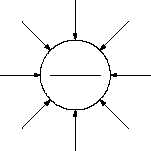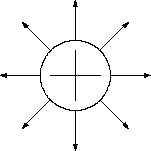Basic Electrical Theory
ATOM AND ITS FORCES
Without this electrostatic force, the electron, which is traveling at high speed, could not stay in
its orbit. Bodies that attract each other in this way are called charged bodies. As mentioned
previously, the electron has a negative charge, and the nucleus (due to the proton) has a positive
charge.
The First Law of Electrostatics
The negative charge of the electron is equal, but opposite to, the positive charge of the proton.
These charges are referred to as electrostatic charges. In nature, unlike charges (like electrons
and protons) attract each other, and like charges repel each other. These facts are known as the
First Law of Electrostatics and are sometimes referred to as the law of electrical charges. This
law should be remembered because it is one of the vital concepts in electricity.
Some atoms can lose electrons and others can gain electrons; thus, it is possible to transfer
electrons from one object to another. When this occurs, the equal distribution of negative and
positive charges no longer exists. One object will contain an excess of electrons and become
negatively charged, and the other will become deficient in electrons and become positively
charged. These objects, which can contain billions of atoms, will then follow the same law of
electrostatics as the electron and proton example shown above. The electrons that can move
around within an object are said to be free electrons and will be discussed in more detail in a
later section. The greater the number of these free electrons an object contains, the greater its
negative electric charge. Thus, the electric charge can be used as a measure of electrons.
Electrostatic Field
Figure 4 Electrostatic Field
A special force is acting between
the charged objects discussed
above. Forces of this type are the
result of an electrostatic field that
exists around each charged particle
or object. This electrostatic field,
and the force it creates, can be
illustrated with lines called "lines
of force" as shown in Figure 4.
Rev. 0
Page 3
ES-01




